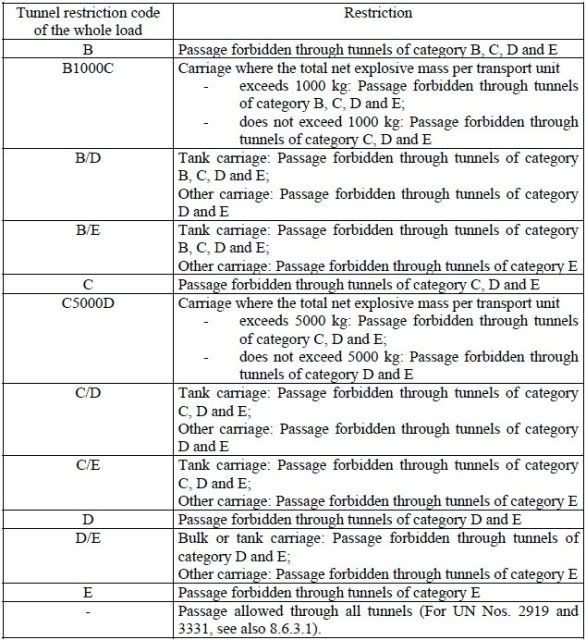Could anyone explain the adr tunnel codes, the piece I downloaded is very confusing. I know they are listed A -E but what I want to know is if I have a load that is classed as C can I travel through a tunnel marked as C.
The sheet I downloaded has Tank carriage and other carriage and there seems different rules between these. I’m not interested in tanks just the packages.
many thanks
bob
No if you carrying product with code C then you can only go through A and B tunnels C,D,E are not allowed through. If ive got that right Dave will be along to give me praise if not oppps sorry Dave.
No doubt Dave will be along later to sort it out
■■■:
Could anyone explain the adr tunnel codes, the piece I downloaded is very confusing. I know they are listed A -E but what I want to know is if I have a load that is classed as C can I travel through a tunnel marked as C.
The sheet I downloaded has Tank carriage and other carriage and there seems different rules between these. I’m not interested in tanks just the packages.
many thanks
bob
Hi ■■■,
I’ve no idea of what you downloaded, but here’s how the ADR tunnel restrictions work:
The column on the left is the possible tunnel codes that could be written on your ADR transport document.
The column on the right tells you what the effect of the various restrictions actually is.
I should point out that this table only applies if you exceed the relevant ADR transport category threshold limit, so those who display orange plates when they’re not strictly needed will probably be doing some unnecessary diversions.

Restriction code “C” should now be pretty straightforward.
You’ve spotted the difference on some of the codes as they relate to tankers, so here’s an example that I hope assists you when you see something like “D/E” written. I’ll use the example of petrol carried in drums…
Your transport document would look something like this:
UN 1203 PETROL, 3, PGII (D/E) [The unfamiliar bit at the end in brackets is the ADR tunnel code, which the consignor must provide.]
The meaning of the D/E is:
The “D” = A petrol tanker may not pass through tunnels of categories D and E
The “E” = Other Carriage of petrol [ = packages (drums, IBCs etc)] may not pass through tunnels of category E.
Now here’s the sign for the Mersey Tunnels:
Petrol in drums is OK, but a petrol tanker must divert.
Imp:
No if you carrying product with code C then you can only go through A and B tunnels C,D,E are not allowed through. If ive got that right Dave will be along to give me praise if not oppps sorry Dave.
Hi Imp,
You’re spot on mate, and praise is given. ![]()
I’ll add the proviso that the tunnel restriction ONLY applies when the load exceeds the relevant ADR transport category threshold, ie, when ADR applies in full.
animal:
No doubt Dave will be along later to sort it out
Imp had it covered. ![]()
![]()
Cheers Dave, I think that makes it a bit clearer, if it marked D/E that means D is for tanks and E is for packages and if just has D that is for either.
bob
■■■:
Cheers Dave, I think that makes it a bit clearer, if it marked D/E that means D is for tanks and E is for packages and if just has D that is for either.bob
Hi Bob,
Spot-on mate. 